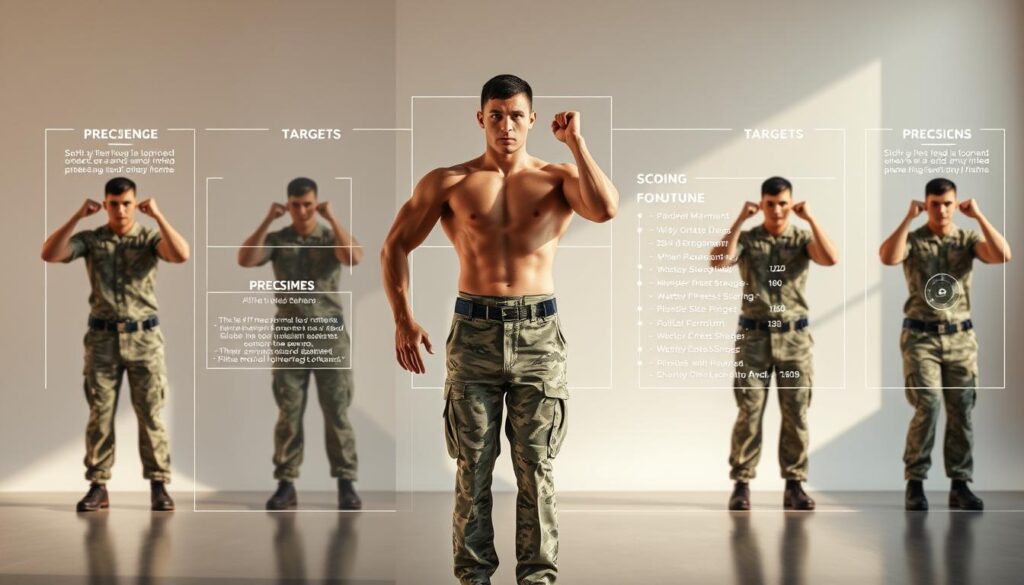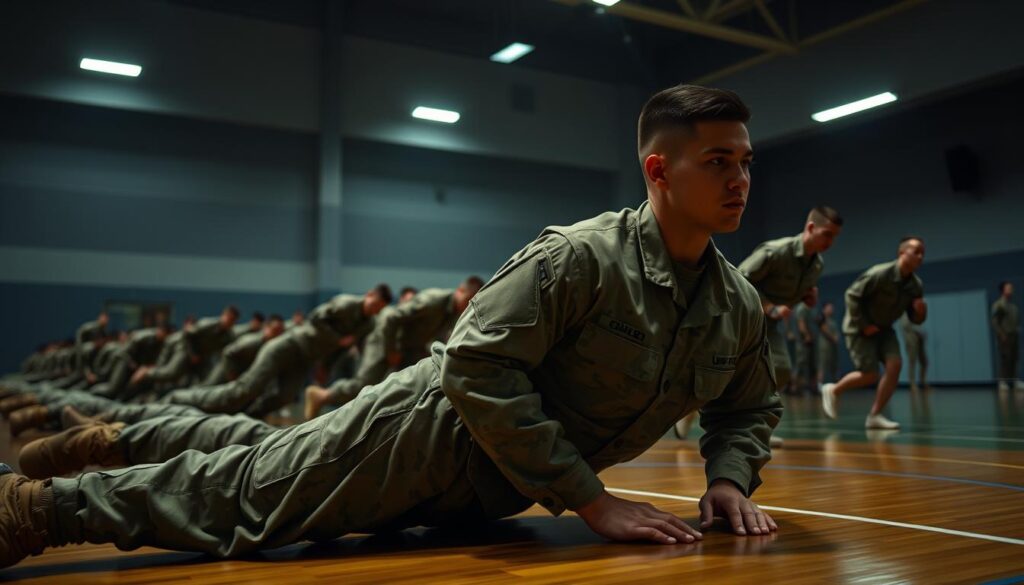Are you ready for the tough demands of military service? The Army’s fitness test checks if you can handle the job. It makes sure you’re fit for duty.
The Army Fitness Test (AFT) is now used instead of the Army Combat Fitness Test (ACFT). It includes the 3 Repetition Maximum Deadlift (MDL), Hand-Release Push-Up (HRP), and Sprint-Drag-Carry (SDC). You’ll also do a Plank (PLK) and a Two-Mile Run (2MR). These tests check your strength, endurance, and how well your heart works.
It’s key to know the military fitness requirements. This helps soldiers get ready for what’s coming. Knowing what to expect makes preparation easier.
Key Takeaways
- The AFT assesses muscular strength, endurance, and cardiovascular fitness.
- The test includes five events: MDL, HRP, SDC, PLK, and 2MR.
- Understanding the fitness standards is essential for soldier preparation.
- The AFT has replaced the ACFT.
- Soldiers must meet the required fitness levels to perform their duties effectively.
Overview of Army Male Fitness Standards
The Army Male Fitness Standards are key to a soldier’s readiness. It’s not just about passing a test. It’s about being able to do the job well in different situations.
The Army has always valued physical fitness. Today’s standards make sure soldiers can handle combat and other military tasks.
Importance of Physical Fitness in the Army
Physical fitness is crucial in the Army. It helps soldiers do their jobs better. Being fit also lowers the chance of getting hurt.
The Army’s fitness test shows if a soldier is ready. For more on Army fitness, check out the Army fitness page.
Objectives of Fitness Standards
The Army’s fitness standards aim to prepare soldiers for military tasks. They check if soldiers can do tasks that need endurance, strength, and agility. The Army Fitness Test (AFT) replaced the old test to better prepare soldiers and reduce injuries.
History of Fitness Evaluations
The Army has tested its soldiers’ fitness for many years. The latest test, the AFT, shows the Army’s dedication to keeping standards up with today’s needs. The Army also recognizes the different physical needs of men and women, as explained on this page.

Physical Fitness Test Components
The Army Male Fitness Standards test a soldier’s physical abilities in several ways. The Army Physical Fitness Test (APFT) has key parts. Each part checks different parts of physical fitness.

Push-Up Requirements
Push-ups test muscular endurance, a key part of fitness. Soldiers must do a certain number of push-ups in 2 minutes. The number needed changes with age and fitness level.
- Proper Form: Soldiers must keep their body straight from head to heels during the exercise.
- Repetition Count: Only full push-ups done in 2 minutes count. Partial or wrong ones don’t.
Sit-Up Requirements
Sit-ups check core strength and endurance. Like push-ups, soldiers have 2 minutes to do as many sit-ups as they can.
- Proper Technique: Start with knees bent and feet flat. Lift your torso until your elbows touch your knees.
- Repetition Criteria: Sit-ups are counted if done right and in time.
2-Mile Run Standards
The 2-mile run tests cardiovascular endurance. Soldiers aim to finish the run as fast as they can. The run’s standards also change with age and fitness level.
- Preparation: Good training is key, focusing on endurance and speed.
- Performance: Times are recorded, and scores are based on age and run time.
Knowing and meeting these standards is key for a good score on the Army Physical Fitness Test. Each part tests a different fitness aspect. This ensures a full check of a soldier’s readiness.
Scoring and Evaluation Process
The Army Fitness Test (AFT) is key to a soldier’s fitness check. It aims to be fair, showing a soldier’s fitness across different ages and genders.
The AFT has three parts: push-ups, sit-ups, and a 2-mile run. Each part is scored based on how well a soldier does. The total score shows their fitness level.
Scoring Criteria for Each Component
The AFT scores each part differently. For example, push-ups and sit-ups are counted in 2 minutes. The 2-mile run is timed, with faster times showing better fitness.
Push-ups are scored by how many are done in 2 minutes. More push-ups mean better upper body strength and endurance.
Sit-ups are scored by how many are done in 2 minutes. This shows core strength and endurance.
Age and Gender Adjustments
The AFT scores are adjusted for age and gender. This makes the test fair for everyone. It takes into account how fitness changes with age and between genders.
Older soldiers get more lenient standards. This is because physical abilities naturally decline with age. Gender adjustments are also made. They reflect the average fitness differences between men and women.
Performance Expectations
Soldiers must meet minimum scores for their age and gender to pass the AFT. These standards ensure soldiers stay fit for their duties.
Meeting these standards means passing the AFT and staying physically fit. This supports military readiness and effectiveness.
Health and Wellness Programs
Health and wellness programs are key for soldiers’ fitness and readiness. They help soldiers meet the army fitness test standards. These programs focus on nutrition, injury prevention, and resources.
Nutrition’s Impact on Fitness
Good nutrition is vital for soldiers to excel in the physical fitness test army. A balanced diet fuels their training and recovery. It helps them reach the fitness standards needed.
The Army teaches soldiers about the right foods. They learn how to fuel their bodies for energy and health.
Injury Prevention Strategies
Injury prevention is a big part of the Army’s health and wellness. It teaches soldiers to avoid injuries. This way, they can stay in training without getting hurt.
Preventing injuries includes warm-ups, strength training, and flexibility exercises. These help soldiers stay fit and pass the army fitness test standards.
Resources for Army Personnel
The Army offers many resources for fitness. These include fitness experts, nutrition advice, and mental health support.
| Resource | Description | Benefit |
|---|---|---|
| Fitness Professionals | Personalized training plans | Improved fitness performance |
| Nutritional Guidance | Dietary planning and education | Optimal nutrition for training |
| Mental Health Support | Counseling and stress management | Enhanced mental resilience |
Preparing for the Army Male Fitness Standards
To do well in the army male PT test, knowing the US army physical fitness standards is key. A good plan includes cardio, strength training, and flexibility exercises. This mix helps prepare you for the test.
Training should include long slow distance (LSD) runs, pace runs, and interval training. These improve your endurance. Strength training should focus on tasks like carrying gear or lifting heavy equipment. For more tips on the army weight standard, check out the Health Weight Calculator website.
Training Regimens and Tips
A good training plan should target the test’s components. This means focusing on push-ups, sit-ups, and the 2-mile run. By working on these areas and tracking your progress, you can reach your goals in the US army physical fitness standards.
Common Challenges and Solutions
Soldiers often face challenges like injuries or hitting a plateau. To beat these, it’s important to prevent injuries and adjust your training as needed.


